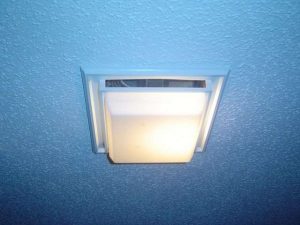Why and How to Vent a Bathroom Ceiling Fan
By Mark J. Donovan
|
|
Venting a bathroom ceiling fan is critical for preventing the growth of mold and mildew in your home and attic. Simply installing a bathroom ceiling fan and letting it vent out into a large attic space is not good enough. The moist warm air shot into the attic from the bathroom ceiling fan causes condensation on the interior roof sheathing and attic walls. This condensed moisture can quickly lead to black mold growth. Mold and mildew in the home can cause respiratory issues with you and your family and can negatively impact the value of your home when you go to sell it someday.
If you see signs in your attic of dark spots or patches on the interior attic roof and walls you already have a mold problem. |
To remove the mold, spray on to the affected areas a bleach/water mixture to kill it. After the bleach/water mixture has had a few minutes to work, scrub the walls and roof with a coarse rag or brush to remove the mold. Make sure, however, that you where a respirator when removing the mold. You don’t want to be breathing in the mold spores.
| Installing a Bathroom Ceiling Fan Vent
To vent a bathroom ceiling fan you have a couple of options. You can either vent it out the top of the roof or vent it out the soffit area of the roof. Venting it out the top of the roof is functionally the best way as it enables a direct upward line from the bathroom ceiling fan outlet to the roof. However, installing a roof vent takes some skill and significant effort. Improperly installing a roof vent can lead to roof leaks. The other alternative for venting a bathroom ceiling fan is to install a circular soffit vent into the soffit area of the roof. |
 |
The soffit is the area just under the eaves of the roof. Simply use a hole saw to cut out the proper size circular hole. Then connect flexible vent tubing from the bathroom ceiling fan to the newly installed soffit vent. When at your home improvement store look for a soffit vent that has the same diameter dimensions as the bathroom ceiling fan vent hole. Also, you may want to connect a short length of tubular tin, with the same diameter dimensions, to the backside of the soffit vent before installing the vent itself. This way the flexible vent tubing can easily slide over the tubular tin and create a tight seal. A large tie wrap can also help in creating a tight seal.
For help on your bathroom remodeling project, see my Bathroom Remodeling Bid Sheet. The Bathroom Remodeling Bid Sheet provides a request for quote checklist section that you can provide to prospective bathroom remodeling contractors. It also includes a comprehensive bathroom remodeling cost breakdown table, in Microsoft Excel format, that allows the contractor to include his projected remodeling costs for every phase of the project.
Related Information
Additional Bathroom Remodeling Design Resources
 |
 |
Get Free Bathroom Remodeling Price Quotes with No Obligation!
Fill out our 3-5 minute quick and easy form, and receive a free price quote on bathroom remodeling from one of our prescreened and licensed bathroom remodeling contractors. This process is free and there is no obligation to continue once you receive your bathroom renovation price estimate.
